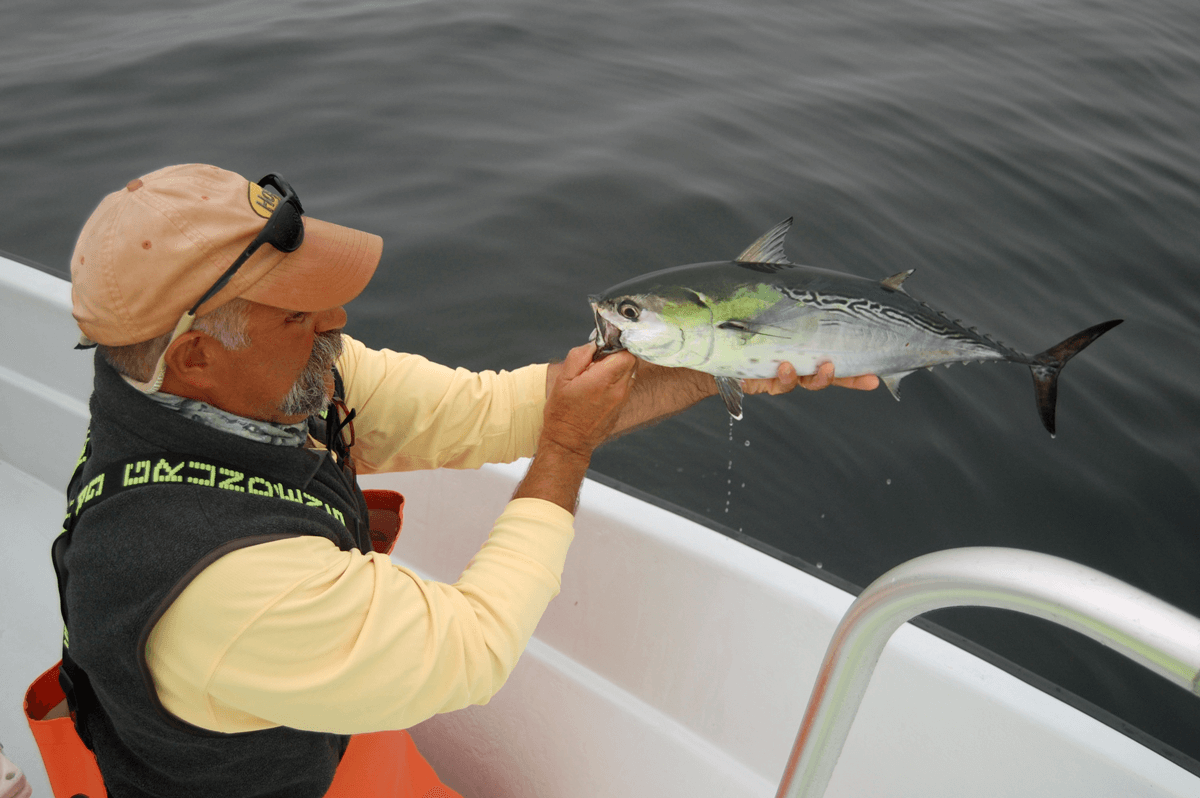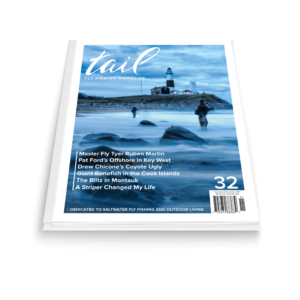By Robert Lewis
(originally published in Tail #33 – January 2018)
In many ways, false albacore are the perfect target species on a fly rod. They provide amazing topwater exhibitions, with birds screeching, bait spraying and greenbacks slashing through the helpless prey. Albies are in the tuna family and are true speed demons. Once hooked, they typically take an initial run that peels hundreds of feet of backing from your reel in a matter of seconds. They are found in many places up and down the east coast and can be caught from shore, kayaks and small center consoles. I have a friend that has caught over 40 of them this past fall from the beach in my hometown. They truly provide light tackle inshore fishing at its best.
I have been lucky to catch albies at Cape Cod, Montauk, Cape Lookout and West Palm Beach. Since the prime time in each locale is different, it allows me to significantly extend my season. Down in West Palm, the sweet spot is the last two weeks of June into the first few weeks of July. Here on Cape Cod, September is when the most action occurs. Montauk also has great albie fishing in September, but I have always gone around Columbus Day weekend to get my October fix. In North Carolina, November is the best time to be there for big albies, referred to locally as “toads.” The fish at Cape Cod and Montauk average five to eight pounds, with double-digit sized fish possible, but not very common. However, in North Carolina and West Palm, you can expect to catch 12-20 pound false albacore on a regular basis.
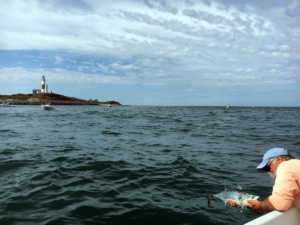 I first heard about the West Palm fishery when I read Tom Gilmore’s book, False Albacore: A Comprehensive Guide to Fly Fishing’s Hottest Fish. Several years later I attended a presentation by Tom at our fly club and he discussed a recent trip with his 11-year-old nephew. He described how this young angler caught an albie on his first cast and went on to have the trip of a lifetime. At that time, I had a fly crazed nephew of similar age, and I decided that would be the perfect trip for the two of us. We enjoyed two days of screaming reels and fat alberts over 15 pounds. Thankfully, my nephew is still fly crazed, and we reunited down in West Palm this past summer with his older brother for another epic trip chasing monster fish.There really is a completely different approach in Florida, with most false albacore raised by live-chumming pilchards. The advantage there is hungry fish busting boat-side and 15-20 pound speedsters in great supply. I have been back there several times and also enjoyed other opportunities for shots at tarpon, tuna, mahi and barracuda. One day I landed more than 20 small blackfin tuna on the fly and have also caught Spanish and king mackerel, snook, jacks and rainbow runners. There is also a pretty famous spinner shark fishery in the February/March timeframe, which I hope to enjoy some day. I have caught my share of sharks over the years, with little enjoyment. However, with full aerial jumps including four to seven rotations to earn their namesake, fishing for spinners seems like an entertaining experience, especially on the fly.
I first heard about the West Palm fishery when I read Tom Gilmore’s book, False Albacore: A Comprehensive Guide to Fly Fishing’s Hottest Fish. Several years later I attended a presentation by Tom at our fly club and he discussed a recent trip with his 11-year-old nephew. He described how this young angler caught an albie on his first cast and went on to have the trip of a lifetime. At that time, I had a fly crazed nephew of similar age, and I decided that would be the perfect trip for the two of us. We enjoyed two days of screaming reels and fat alberts over 15 pounds. Thankfully, my nephew is still fly crazed, and we reunited down in West Palm this past summer with his older brother for another epic trip chasing monster fish.There really is a completely different approach in Florida, with most false albacore raised by live-chumming pilchards. The advantage there is hungry fish busting boat-side and 15-20 pound speedsters in great supply. I have been back there several times and also enjoyed other opportunities for shots at tarpon, tuna, mahi and barracuda. One day I landed more than 20 small blackfin tuna on the fly and have also caught Spanish and king mackerel, snook, jacks and rainbow runners. There is also a pretty famous spinner shark fishery in the February/March timeframe, which I hope to enjoy some day. I have caught my share of sharks over the years, with little enjoyment. However, with full aerial jumps including four to seven rotations to earn their namesake, fishing for spinners seems like an entertaining experience, especially on the fly.
Cape Cod is the place I call home, and I am fortunate to drive by our south-facing beaches on the way to work each day. By late August and early September, I am happy to see the arrival of the albies. Early season spots are from Waquoit Bay to Craigville Beach, and then schools settle all over the south side from the Elizabeth Islands to Monomoy Point. South of the Cape, there is some good fishing at Great Point on Nantucket over to the waters surrounding Martha’s Vineyard. Historically, September is the established month for the best fishing, but in 2017 we had a solid population of albies through most of October due to great weather and an abundance of bait.
Montauk, also known as “the end,” is located at the easternmost tip of Long Island, New York. The locals claim it is the surf casting capital of the world, and many describe it as “a little drinking town with a BIG fishing problem.” There is no question it is a very fishy place. Montauk is also famous for the legendary bass blitzes, with acres of striped bass sipping rain bait on the surface.
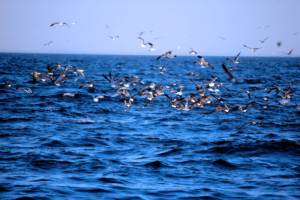 Each morning, a parade of boats exits the harbor and makes the five mile run down to the point. There is a large rip that forms directly off Montauk Light in the direction of Block Island and there is an incredible amount of life, with birds everywhere. Surfcasters also line the shore, and it is an interesting dynamic when schools of breaking fish move in towards the beach. There is an unwritten rule that boat guys should not follow these schools in towards the beach to give the shore crowd a well-deserved shot. There are always a few boats that can’t resist the allure of crashing fish, only to find four-ounce bucktails whizzing at their heads from angry surf guys. I have traveled to Montauk every year since 2010, and this past October we had happy false albacore slashing on the surface for most of the day. I consider Montauk my experimental grounds, because when the point is going off, there are plenty of hungry fish to catch and I can try out all my latest fly creations.
Each morning, a parade of boats exits the harbor and makes the five mile run down to the point. There is a large rip that forms directly off Montauk Light in the direction of Block Island and there is an incredible amount of life, with birds everywhere. Surfcasters also line the shore, and it is an interesting dynamic when schools of breaking fish move in towards the beach. There is an unwritten rule that boat guys should not follow these schools in towards the beach to give the shore crowd a well-deserved shot. There are always a few boats that can’t resist the allure of crashing fish, only to find four-ounce bucktails whizzing at their heads from angry surf guys. I have traveled to Montauk every year since 2010, and this past October we had happy false albacore slashing on the surface for most of the day. I consider Montauk my experimental grounds, because when the point is going off, there are plenty of hungry fish to catch and I can try out all my latest fly creations.
Cape Lookout is located at the southern part of the Outer Banks. The distinct lighthouse with a black diamond pattern was originally built to mark the treacherous shoals surrounding the area. To this day, there are wild horses roaming the beaches on nearby Shackleford Bank. Harkers Island is a well know base camp for albie addicts, but the reality is that breaking fish can be all the way down west to the Bogue Inlet and many anglers launch from a great six ramp facility in Morehead City, inside the Beaufort Inlet. Most anglers are there to target breaking fish, and when the hook goes off, with albies busting as far as the eye can see, it is truly a spectacular sight. When the surface feed slows down, there is a great plan B. Shrimp trawlers work the area and attract albies as their bycatch is discarded off the boats. Many large fish can be caught on sinking lines cast behind the trawlers. In 2016, we had a group of anglers that traveled down to NC from Cape Cod and they caught many fish per day utilizing this method, with most fish in the 17-22 pound range. Some venture through the shoals to the east where some monster toads up to 25 pounds have been caught. Local guide Sarah Gardner is also well-known for her ability to land big redfish in this area.
The Outer Banks is also known as the graveyard for 10-weights. Many visiting anglers show up with the wrong knife for the fight. Personally, I prefer an 11-weight when albies 15+ pounds are in the hood. You certainly can land these fish on 9 or 10-weights, but you simply don’t have the lifting power after the long runs. A swift battle is better for the fish and more likely to avoid opportunistic sharks looking for a quick snack.
There are a couple of events worth attending if you happen to be in NC at the right time. The locals sure do embrace the arrival of late fall hardtails. The Cape Lookout Albacore and Redfish Festival is held around the third week of October, a three-day event that includes a light tackle tournament. In early November, the True Secret Order of False Albacorian Monks hosts a great banquet and BBQ on Harkers Island. Sometimes it’s better to not ask a lot of questions and just enjoy some good food and drink with your fellow albacorians!
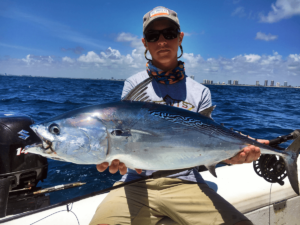
There is no question that fly anglers have a big advantage targeting false albacore. These fish have small mouths and often feed on tiny bait, such as bay anchovies, silversides and peanut bunker. In most cases it is pretty easy to match the hatch with a fly. In addition to common lookalike baitfish patterns, a classic fly for fat alberts is the “tutti frutti,” which is a simple pink over chartreuse combo. There are many versions of this, with the most common one tied in a Clouser style. My favorite is a simple deceiver with lateral line flash down the side. Captain Warren Marshall, a guide lucky to fish his sports in the waters of Cape Cod, Cape Lookout and the Florida Keys, developed the best bay anchovy pattern I have ever seen, a great fly when small bait is on the menu. The fly features a silver belly and lifelike tail made from a hackle cut in the shape of a delta. Captain Scott Hamilton, a long time fly-only guide in West Palm, created the “eat me” fly, which is a great pilchard imitation. Scott also concocted a sensational foam baitfish replica which triggers some incredible topwater explosions. I have experimented with many patterns over the years and strongly agree that the wrong fly with a good presentation is much better than the right fly poorly presented. You have to get the fly moving quickly.
Several years ago, someone suggested I try crease flies on albies, and it turned out to be a game changer for me. It is like a new sport and provides pure entertainment to see greenbacks slashing in at 30+ mph and inhaling a surface offering. The past two years, I have also had success with smaller crease flies, about half the size of a normal crease fly, which are great for smaller and picky albies. Tan over white makes for a killer anchovy imitation, and I have also had some real success with a small tutti frutti crease pattern.
Captain Dave Peros, a salty light tackle guide on Cape Cod, helped me catch my first albie on the fly back in 2010. He pointed out that the huge advantage with a fly rod is that during your retrieve, you can pick up 30’ of fly line and place it somewhere else on breaking fish. Anglers with spin rods need to retrieve the lure all the way back to the boat and then send out a new cast. It is very common to cast out to fish, start a retrieve and then spot a better school ten feet to the right or twenty feet to the left of your fly. You don’t need any false casts in this situation. Simply make one backcast, place your fly right in the middle of the commotion and get ready to come tight.
There are times that albies can be picky. This past fall, I found tight-lipped fish one morning at Montauk and tried about five different flies and presentations. Then I added an 11-pound tippet (down from 20) with my favorite tutti frutti fly and quickly went tight to a fish. Of course, the million dollar question is whether my changes made a difference or the feed just happened to turn on. I guess I will never know, but when the fish are not eating a properly presented fly, I believe you should always change something. Try a crease fly on a floating line, go to a smaller tippet, try a slower retrieve. Make alterations and eventually you will find the right ingredients to make your reel sing.
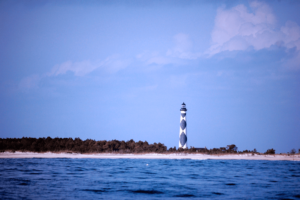
There are other important aspects to catching albies. Presentation is everything: it makes a big difference to have your fly line unroll at the end of your cast and be ready to get that fly moving as soon as it hits the water, rather than a clump of line landing on a school of fish with lots of slack. Since you are targeting a fish that can swim 30-40 mph, try to determine their general direction and lead them by quite a bit. Due to their speed, if you try casting at the fish, rather than leading them, you will often see your fly land behind the fish, and they will never see it. A pod of fish can be at 10 o’clock off the bow of the boat and then pop up behind the boat seconds later. Be ready to drop a back cast or re-direct a forward cast at a moment’s notice. Your ability to quickly place a fly at many different possible locations surrounding the boat, often with wind as a serious factor, will greatly increase your chances of catching.
In many parts of the world, anglers must travel significant miles offshore on large boats to find this type of fishing experience. On the east coast of the US, there are chances to catch amazing pelagics from shore and areas close to shore, which is one of the reasons fishing for allies is such an amazing and accessible experience for fly anglers.

